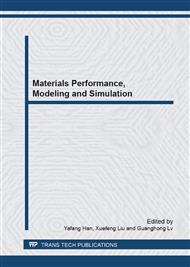[1]
J. Banhart, Manufacture, characterisation and application of cellular metals and metal foams, J. Sci. Progress in Materials Science. 46 (2001) 559–632.
DOI: 10.1016/s0079-6425(00)00002-5
Google Scholar
[2]
H. Nakajima, T. Ikeda, S.K. Hyun, Fabrication of lotus-type porous metals and their physical properties, J. Sci. Advanced Engineering Materials. 6 (2004) 377–384.
DOI: 10.1002/adem.200405149
Google Scholar
[3]
T. Nakahata, H. Nakajima, Fabrication of lotus-type porous silicon by unidirectional solidification in hydrogen, J. Sci. Materials Science and Engineering A. 384 (2004) 373–376.
DOI: 10.1016/s0921-5093(04)00911-6
Google Scholar
[4]
Y. Liu, Y.X. Li, H.W. Zhang, Fabrication of lotus-structured porous magnesium with gasar process, J. Sci. Acta Metallurgica Sinica. 40 (2004) 1121–1126.
Google Scholar
[5]
Y. Liu, Y.X. Li, R.F. Liu, Theoretical analysis on effect of transference velocity on structure of porous metals fabricated by continuous casting gasar process, J. Sci. Acta Metallurgica Sinica. 46 (2010) 129–134.
DOI: 10.3724/sp.j.1037.2009.00527
Google Scholar
[6]
Y. Liu, Y.X. Li, J. Wan, H.W. Zhang, Metal-gas eutectic growth during unidirectional solidification, J. Sci. Metallurgical and materials transactions A. 37A (2006) 2871–2878.
DOI: 10.1007/bf02586119
Google Scholar
[7]
H. W. Zhang, Theoretical and experimental study on unidirectional solidification of metal-Gas eutectics. Beijing, Tsinghua University, 2006, pp.23-24.
Google Scholar
[8]
T. Ogushi, H. Chiba, H. Nakajima, T. Ikeda, Measurement and analysis of effective thermal conductivities of lotus-type porous copper, J. Sci. Journal of applied physics. 95(2004) 5843–5847.
DOI: 10.1063/1.1691188
Google Scholar
[9]
S. Ueno, S. Y. Kim, H. Nakajima, Effect of molten temperature on the formation of lotus-type porous silicon during unidirectional solidification, Proceedings of MetForm2005, Tokyo: The Japan Institute of Metals, 2006: 225–228.
Google Scholar
[10]
Y. Liu, Y.X. Li, J. Wan, Evaluation of porosity in lotus-type porous magnesium fabricated by metal/gas eutectic unidirectional solidification, J. Sci. Materials Science and Engineering A. 402 (2005) 47–54.
DOI: 10.1016/j.msea.2005.03.107
Google Scholar
[11]
H.W. Zhang, Y.X. Li, Y. Liu, Evaluation of porosity in lotus-type porous Cu fabrication with gasar process, J. Sci. Acta Metallurgica Sinica. 42 (2006) 1165–1170.
Google Scholar
[12]
T.K. Kostina, B.A. Baum, K.T. Kurochkin, Solubility of hydrogen in silicon, J. Sci. Inorganic Mater. 6 (1970) 94-95.
Google Scholar
[13]
K.A. Jackson, J.D. Hunt, Lamellar and rod eutectic growth, J. Sci. Transactions of the metallurgical society of AIME. 236 (1966) 1129-1142.
Google Scholar
[14]
K. Murakami, H. Nakajima, Formation of pores during unidirectional solidification of water containing carbon dioxide, J. Sci. Materials Transactions. 43 (2002) 2582-2588.
DOI: 10.2320/matertrans.43.2582
Google Scholar


